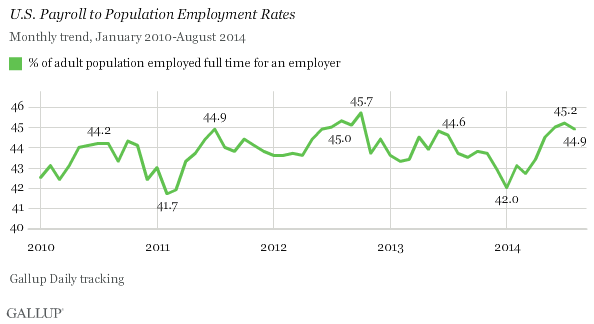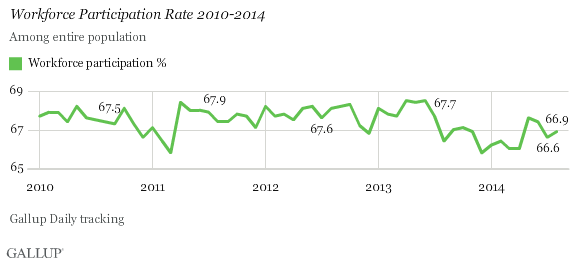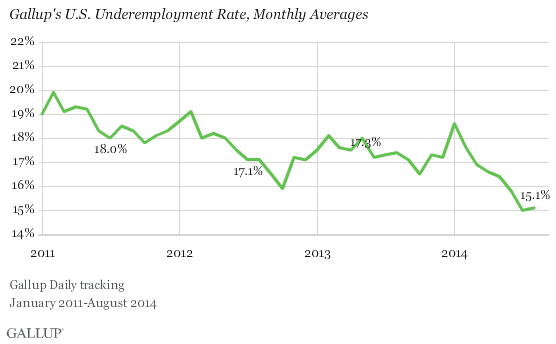WASHINGTON, D.C. -- The U.S. Payroll to Population employment rate (P2P), as measured by Gallup, was stable in August. The 44.9% of Americans employed full time for an employer in August is similar to the 45.2% in July, but it is also among the highest rates recorded since Gallup began tracking P2P in January 2010.

Gallup's P2P metric tracks the percentage of the U.S. adult population aged 18 and older who are employed by an employer for at least 30 hours per week. P2P is not seasonally adjusted. However, because of seasonal fluctuations, year-over-year comparisons are often helpful in evaluating whether monthly changes are attributable to seasonal hiring patterns or true growth (or deterioration) in the percentage of people working full time for an employer.
The August P2P rate is often one of the higher monthly measurements each year, so it is not unexpected to see relatively high readings in August. Even so, this year's 44.9% is higher than the 43.7% in August 2013.
The latest results are based on Gallup Daily tracking interviews with 30,375 Americans, conducted Aug. 1-31 by landline telephone and cellphone. Gallup does not count adults who are self-employed, work less than 30 hours per week, are unemployed, or are out of the workforce as payroll-employed in the P2P metric.
Workforce Participation at 66.9%
Though workforce participation had fallen in recent months -- dipping to 66.6% in July -- it saw no decrease for the first time in three months, inching up slightly to 66.9%.
Workforce participation measures the percentage of adults who are working, or who are not working but are actively looking for work and are available for employment. The workforce participation rate has ranged narrowly between lows of 65.8% to highs of 68.5% since January 2010.

Compared with the averages of previous years' figures, 2014 is slated to have the lowest annual workforce participation figure. Workforce participation rates in recent months, however, have been significantly higher than those in the early months of the year. In May, workforce participation reached a 10-month high.
Unadjusted Unemployment Remains at Previous Low of 6.3%
After dropping to a new low in the four-plus year trend in July, Gallup's U.S. seasonally unadjusted unemployment rate maintained that 6.3% level in August. In previous Augusts, Gallup has measured unemployment rates of 8.7% in 2013, 8.1% in 2012, 9.2% in 2011, and 9.4% in 2010, so the trend is clearly toward lower unemployment. Gallup's U.S. unemployment rate represents the percentage of adults in the workforce who did not have any paid work in the past seven days, for an employer or themselves, and who were actively looking for and available to work.

Underemployment, at 15.1%, Near Previous Low
After falling to 15.0% in July, the lowest in the four-plus year trend, Gallup's measure of underemployment essentially remained flat in August, at 15.1%. This is a marked improvement from the 15.8% in June and from estimates typically higher than 17% prior to 2014. Gallup's U.S. underemployment rate combines the percentage of adults in the workforce who are unemployed (6.3%) and those who are working part time but desire full-time work (8.8%).

Bottom Line
The stability in Gallup's P2P and unemployment measures is a positive sign for employment as well as the economy more generally. Looking ahead to this month, Gallup has only seen decreases between August and September since 2010 -- ranging from .3 to 1.3 percentage points, so it's likely P2P in September 2014 will be down. Given this seasonal pattern, the key will be how September 2014 P2P compares with previous Septembers. Unless there is an abnormally large decrease in P2P this month, it should compare favorably to prior Septembers.
Although workforce participation rates are lower in 2014 than prior years, its small uptick of .4 percentage points in August is the first increase the measure has seen in three months. Workforce participation rates reflect several different factors, including the demographic composition of the population, so its relative rise and fall reflects more than just the health of the job market. Still, overall workforce participation, P2P, and unemployment -- as well as employee reports of hiring activity where they work -- have all generally been more positive this year than at the end of 2013, which is a better sign than if all had been moving in a more negative direction.


Note: Reporting of the July 2014 P2P, workforce participation, and underemployment numbers in this article differ by 0.1 percentage points from the numbers cited for July in this article. This results from the exclusion of July 30-31 in the July 2014 reporting, because of reporting deadlines.
Gallup.com reports results from these indexes in daily, weekly, and monthly averages and in Gallup.com stories. Complete trend data are always available to view in the following charts:
Daily: Employment, Economic Confidence, Job Creation, Consumer Spending
Weekly: Employment, Economic Confidence, Job Creation, Consumer Spending
Read more about Gallup's economic measures.
View our economic release schedule.
Survey Methods
Results for this Gallup poll are based on telephone interviews conducted Aug. 1-31, 2014, on the Gallup Daily tracking survey, with a random sample of 30,375 adults, aged 18 and older, living in all 50 U.S. states and the District of Columbia.
For results based on the total sample of national adults, the margin of sampling error is ±1 percentage points at the 95% confidence level.
Interviews are conducted with respondents on landline telephones and cellular phones, with interviews conducted in Spanish for respondents who are primarily Spanish-speaking. Each sample of national adults includes a minimum quota of 50% cellphone respondents and 50% landline respondents, with additional minimum quotas by time zone within region. Landline and cellular telephone numbers are selected using random-digit-dial methods. Landline respondents are chosen at random within each household on the basis of which member had the most recent birthday.
Samples are weighted to correct for unequal selection probability, nonresponse, and double coverage of landline and cell users in the two sampling frames. They are also weighted to match the national demographics of gender, age, race, Hispanic ethnicity, education, region, population density, and phone status (cellphone only/landline only/both, and cellphone mostly). Demographic weighting targets are based on the most recent Current Population Survey figures for the aged 18 and older U.S. population. Phone status targets are based on the most recent National Health Interview Survey. Population density targets are based on the most recent U.S. census. All reported margins of sampling error include the computed design effects for weighting.
In addition to sampling error, question wording and practical difficulties in conducting surveys can introduce error or bias into the findings of public opinion polls.
For more details on Gallup's polling methodology, visit www.gallup.com.
